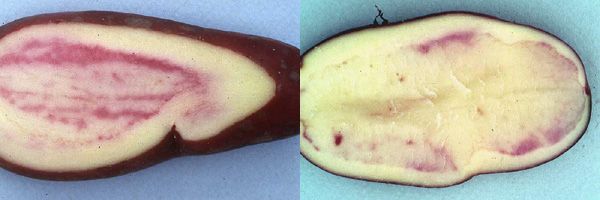
Pink pigmentation of the flesh or of the skin
- Symptoms
Two types of pink colouration may be observed in the flesh of the tubers:
- purplish-pink colouration is very clearly defined and localised at the vascular ring and takes the form of an unevenly shaped area;
- the pink colour is more or less intense and takes the form of mottling, usually localised in the pith of the tubers but sometimes taking up virtually all of the volume of the flesh (photos 1 to 3).
Additionally, pink colouration of the skin may also be observed externally in several yellow- skinned cultivars which are to varying degrees also susceptible to this anthocyanic pigmentation. This may also affect the eyes or possibly the entire surface of the tuber (Belle de Fontenay, Estima, Caesar, Samba among others) (photo 4).
Pigmentation of the eyes may, however, be a genetic characteristic of some cultivars (photo 5).
- Risk factors
The first type of pink colouration of the flesh sometimes occurs in cultivars such as Bintje or Rosa when infected by Potato leaf roll virus (PLRV).
The second type affects mainly cv. Roseval. The pigment responsible for this colouration is not toxic and is related to those found in wine and red cabbage.
The percentage of tubers affected increases during the vegetative period.
Anthocyanic pigmentation of the skin occurs as a reaction to light (photo 4) or stress.
With the latter, a number of environmental factors would appear to favour its appearance in crops. For example:
- light: tubers situated on the surface of the ridges are often more affected;
- alternating cool nights and hot days;
- a dry soil or one rich in nitrogen.
- Control measures
The extent of the symptoms of pink flesh pigmentation can be limited by preparing large ridges and by frequent, but not excessive, irrigation.
As regards skin pigmentation, tubers should not be exposed to daylight except during the handling operations required for harvesting, storage and packing, and to as little as possible direct sunlight.





